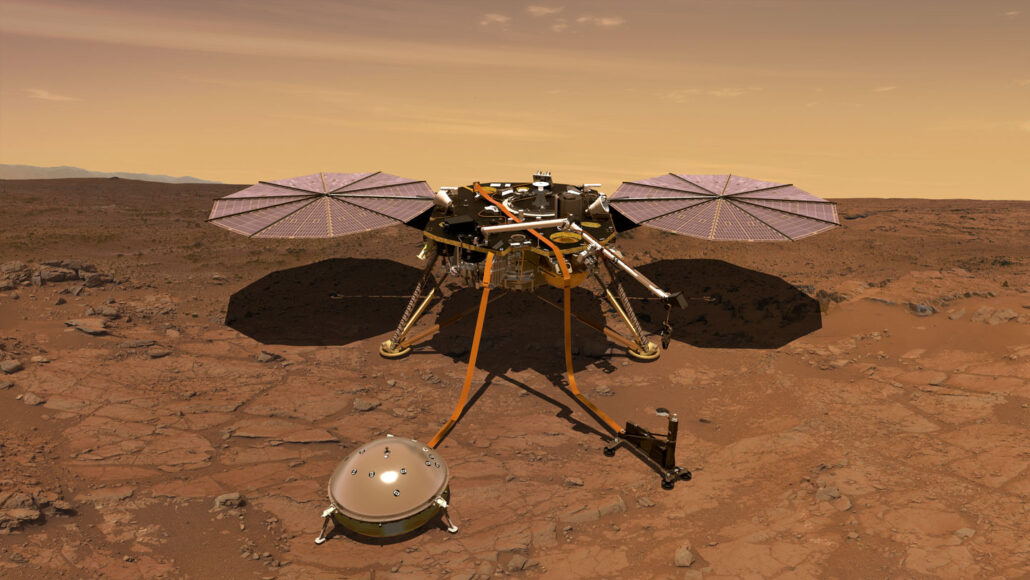
Earth has earthquakes. Mars has marsquakes. There is just one difference: marsquakes are most frequently caused by meteoroid crashes since the Red Planet lacks the tectonic plates that shift pieces of crust on Earth. So what caused the most intense marsquake ever when there has been no evidence of a collision?
Vibrations from the 4.7 magnitude quake sent tremors through the Martian crust for six hours (if not more) and were captured by NASA’s InSight lander in May 2022. Otherwise known as S1222a, this marsquake was assumed to have been caused by a meteoroid impact, so an international team of researchers immediately began searching for evidence of a fresh crater. The problem was that none existed. That's when the team, led by planetary geophysicist Benjamin Fernando, began thinking that something was potentially going on beneath the surface.
“We undertook a comprehensive search of the region in which the marsquake occurred,” Fernando and his team said in a study recently published in Geophysical Research Letters. “We did not identify any fresh craters in the area, implying that the marsquake was likely caused by geological processes.”
An invisible culprit
There would have been almost no way to miss the hypothetical crater left in the wake of S1222a if one was actually there. The researchers estimated that it would have had to be no less than 300 meters (about 1,000 feet) in diameter.
InSight had previously identified eight marsquakes caused by impacts, the largest two being 150 meters (500 feet) in diameter each. There were similarities between those and S1222a, as these were the only three events for which seismic waves were identified on the surface. The waves also lasted for extended periods, up to 10.5 hours for S1222a. Another thing all three events shared was energy that spanned a broader range of frequencies than other marsquakes. It seemed that these were indicators of another impact quake—but wait.
Despite the similarities that seemed to point to a meteorite faceplanting on Mars, there were obvious differences the team could not ignore. The magnitude of S1222a far surpassed the other two quakes it was similar to, and a greater variety of seismic waves came out of this quake than either of the others.
Still, Fernando and his colleagues decided to search for an impact crater. The craters from both previous events were surrounded by darker blast zones that could be seen even in low-resolution images from the Mars Reconnaissance Orbiter’s MARCI (Mars colour Imager) instrument. There was no doubt that a crater from S1222a would have had to have an even larger blast zone. Except there was no crater or blast zone to be seen.
If S1222a had been caused by an impact and a crater had formed, the scientists came to the conclusion that one of two things must be true. The crater might have been too small for it or its blast zone to be imaged by current instruments. Alternately, it may have formed on a part of the surface with especially strange topography that made it difficult to see or did not have much dust. But Mars is a dusty planet, and the low-dust hypothesis could be ruled out because S1222a was localized to a region covered with reddish dust. Even medium and high-resolution images from various spacecraft showed no craters or blast zones that would match something created by S1222a.
Beneath the surface
If the perpetrator wasn’t a space rock, what could have possibly caused the largest known marsquake? In the absence of a massive crater, blast zone, or dust clouds that could have possibly matched the magnitude of S1222a, the team finally came to the conclusion that subsurface forces must have been behind the quake.
“The only explanation which is consistent with current observations is a subsurface tectonic source,” they said in the same study.
But how could there be a geological source without tectonic plates on Mars? Tectonic forces can be generated by anything that has a sizeable effect on the crust of a planet, not just the sliding plates that cause phenomena such as quakes and volcanoes on Earth. Fernando suggests that S1222a is possibly the result of the Martian crust undergoing immense stress from cooling and shrinking for billions of years.
These processes do not all happen evenly across the entire planet. Different regions may undergo changes at different times, and why some regions of Mars are more stressed than others is a mystery that scientists continue to investigate.
Tectonic forces on an alien planet may be drastically different than those on Earth, but at least the prime suspect thought to have caused S1222a is now ruled out. Future spacecraft with even more seismic wave detection power than InSight may gradually tell us what is happening beneath that red, rocky, sun-blasted surface.
Geophysical Research Letters, 2023. DOI: 10.1029/2023GL103619.



3175x175(CURRENT).thumb.jpg.b05acc060982b36f5891ba728e6d953c.jpg)
Recommended Comments
There are no comments to display.
Join the conversation
You can post now and register later. If you have an account, sign in now to post with your account.
Note: Your post will require moderator approval before it will be visible.